
This is one of two dishes I prepared to participate in Foodalogue’s Culinary Tour, this time visiting my stomping grounds, Panama! This dish came to be as a result of a ‘What’s in the Bag‘ challenge posed by my dear Hubbz. He went to the store and brought everything but the butcher’s block, which I then had to incorporate into a Latin meal.
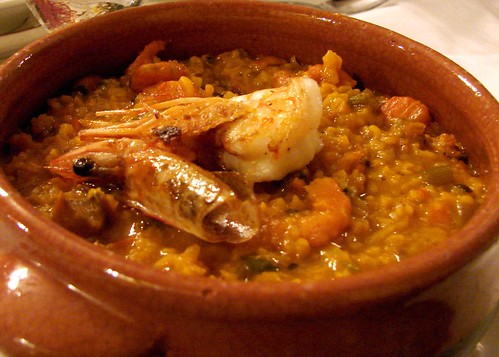
Seafood Guacho at Las Tinajas in Panama
Guacho (pronounced Wah-cho) is a popular Panamanian specialty; a slightly soupy rice dish, similar to an Italian risotto or a Puerto rican asopao. Unlike risotto, guacho is made from regular, long grain white rice that is soaked in water for a bit before it is sautéed and simmered in the cooking liquid of choice. The dish is then flavored and augmented with an array of local ingredients; there’s always some sort of meat or protein from pork, chicken, cured pig’s tails, or seafood, in addition to various beans and roots such as yuca and otoe.
Different from the way I’ve usually explained how to cook rice, the rice in guacho wants for more liquid and a longer cooking time, this allows for the rice starches to develop into a creamy, rich frenzy. I pretty much stuck to the traditional elements of the dish, only straying away in the preparation of the sofrito and by adding mushrooms to the rice itself.
Panamanian sofrito is generally made with onions, bell peppers, tomatoes, garlic and a few other aromatics, this time I included dried chile ancho and guajillos. But enough chatter, let’s cook!

Guacho de Mariscos y Hongos (Seafood & Mushroom Guacho)
6-8 servings
For the guacho:
2 cps long grain rice, soaked
Water
1/2 cp bacon, chopped
Extra virgin olive oil
1 cp mushrooms, diced
1/2 cp shallots, diced
About 8 cps seafood broth
1 cp shrimp, peeled & deveined
1 cp scallops
Sea salt
5 tbsps chile puree
2 cps sofrito
For the sofrito:
2 tbsp extra virgin olive oil
1 cp yellow onions, finely chopped
1 clove garlic, crushed
3 green onion sprigs, finely chopped
3 ripe tomatoes, finely diced
6 tbsps chile puree
Sea salt and a pinch of sugar
In a medium pan heat the oil and add the onions, cook them until soften before adding the garlic and green onions. Then add the tomatoes, 1/2 cp water and chile puree, lower the temperature and allow it to simmer for about 20 minutes. Keep warm.

For the seafood broth: I used the skins from the shrimp, bringing them to a simmer with plenty of water, 1 clove garlic, one of the dry ancho chilies, cilantro (culantro, if you can find it), 1 carrot, salt & pepper. Strain and set aside.
For the chile puree: Rinse and seed the chilies–remember Panamanian food is not typically spicy hot. Put 2 ancho and 1 guajillo chilies in a small pot with 2 cps water, 1 clove garlic, a pinch of salt and simmer for about 10 minutes until the chilies soften. Allow it to cool before running it through the blender. Set aside.
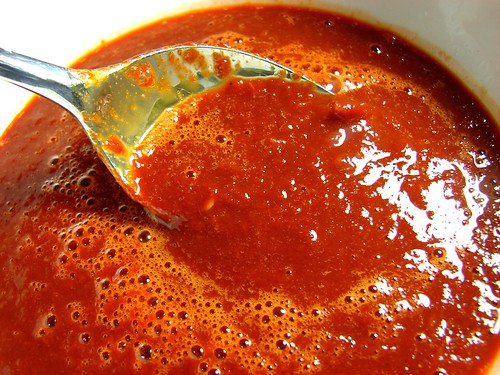
For plating: Reserve a few shrimp and scallops to place over the finished dish.
Preparation – Guacho:
Rinse the rice, then add enough cool water to cover it and allow it to soak for at least 20 minutes and up to 1 hour. In a large pan, render the fat from the bacon, but don’t crisp it. Add the onions and allow to cook until they begin to soften. Then add the mushrooms and cook for about 3 minutes.
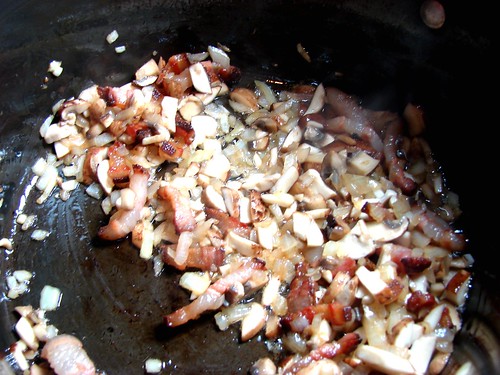
Drain the rice and add to the pan. If necessary, add a bit more olive oil, just enough to coat all the grains. Add 2 tbsps of the chile puree, 6 cps of the seafood broth and adjust the seasoning by adding sea salt as necessary. Lower the temperature to medium-low and allow it to simmer until the broth evaporates. Stir it every so often to make sure nothing gets stuck to the bottom of the pan.

While the rice is cooking, prepare the seafood: chop the shrimp and scallops to bite sizes (remember to save a few of each for plating). Marinate all the seafood (including those for plating) with 2 tbsps of the chile puree and a bit of sea salt and black pepper; set aside until needed.
Once the broth has evaporated, check the doneness of the rice grains. They should be fully open and swollen. If the liquid has evaporated completely, add a bit more broth or water, then add the chopped seafood. Stir in the seafood, bring the temperature to low and allowing to cook covered for another 5 minutes.

In the meantime, saute the reserved shrimp in a bit of olive oil, set aside. When ready to serve, spoon some guacho on the bottom of a bowl, top generously with a couple tbsps of sofrito and top with the sautéed seafood. Enjoy and Buen Provecho!

For the rest of the yummy guacho shots, follow this link. You can also see  the other dish, Langostinos en Caramelo de Maracuyá (Prawns in Passion Fruit Caramel) by following this link. And don’t miss the entries submitted by other food bloggers, visit Foodalogue for the tasty bits.
the other dish, Langostinos en Caramelo de Maracuyá (Prawns in Passion Fruit Caramel) by following this link. And don’t miss the entries submitted by other food bloggers, visit Foodalogue for the tasty bits.
Cookingly yours,
Anamaris
The first time I came across Joan’s blog, Foodalogue, was because of her Culinary Tour events. She chooses a country and invites her readers on a  virtual tour of that country and its cuisine. Joan’s rules for her tour are very relaxed; one can make a traditional dish in a traditional way, OR modernize a traditional dish, OR utilize the ingredients and/or techniques of the country in your own way. The world tour will end this year visiting 7 new countries and Panama will be kicking things off.
virtual tour of that country and its cuisine. Joan’s rules for her tour are very relaxed; one can make a traditional dish in a traditional way, OR modernize a traditional dish, OR utilize the ingredients and/or techniques of the country in your own way. The world tour will end this year visiting 7 new countries and Panama will be kicking things off.
As a 100% Panameña (that’s Panamanian for non-Spanish speakers), I am required to participate and represent. Really, it’s in the constitution or something. When most people think of Panama, they think of the Panama Canal and Noriega, so before we dive into the grub, let me share some so facts regarding my homeland.
- Our borders are the Caribbean Sea, the Pacific Ocean, Colombia and Costa Rica.
- According to the 2010 country rankings by the World Economic Council of Global Competitiveness, Panama ranks 53 out of 139 countries and is expected to end up in the top 50 this year.
- As of 2010 it is the second most competitive economy in Latin America.
- Panama has the largest rainforest in the Western Hemisphere outside the Amazon.
- Basketball is big there and a number of well-known NBA players hail from the little country, including Rolando Blackman (four-time NBA All-Star) and Kevin Daley of the Harlem Globetrotters.
- Another big game, baseball. Rod Carew and Mariano Rivera both hit balls in Panama before hitting the big time.
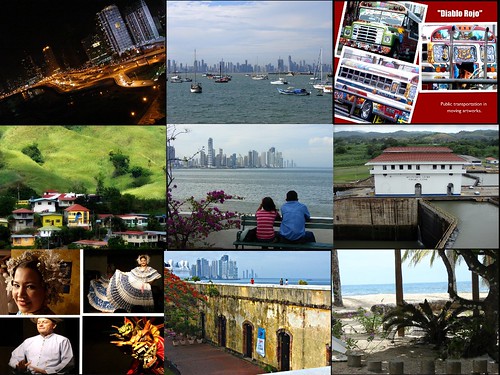
- Panama’s cuisine is influenced by its diverse population of Hispanic, native Indian, European, African and even Chinese migrations.
- Unlike many of the neighboring countries, Panamanian food is not particularly spicy (heat).
- Yellow corn is often used for many of our dishes and fish, seafood and shellfish dishes are Panamanian specialties. For more detailed food info, check this link.

Anydoo, this past year I’ve shared many recipes and told you about foods from Panama and you can be assured that there are plenty more to come starting with 2 dishes I submitted for Joan’s tour. The first is a modern rendition using local ingredients, which could work as a beautiful appetizer, though The Hubbz and I scarfed it down as our entrée the other night. The second came as a result of one of our ‘What’s in the Bag‘ evenings. The Hubbz went to the store and brought everything but the butcher’s block, which I then had to incorporate into a meal. It is a pretty traditional dish, with a very tiny itsy bitsy twist. Ready? Here we go.
For an appetizer: Langostinos en Caramelo de Maracuyá con Aire de Coco (Prawns in Passion Fruit Caramel and Coconut Foam).
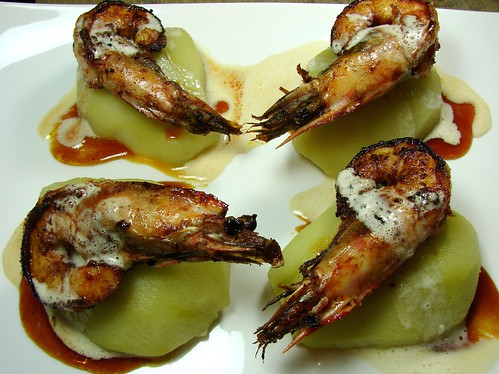
This was incredible with an exciting and complex flavor profile. I followed a recipe from Jorge Jurado’s latest cookbook ‘Sabores de Panamá‘ (Flavors of Panama). Jurado is a renown chef in Panama, who is at the forefront of a movement to elevate Panamanian dishes to haute cuisine.
In this recipe, Jurado makes use of popular local flavors: shrimp, passion fruit, chayote squash, coconut and sugar cane and hypes them up with fish sauce and smoked paprika. The final dish is assembled a layer at a time and topped with coconut foam–which I wasn’t able to accomplish, but still ended up with an insanely delicious sauce that tasted of the sea and tropical fruits. That sauce alone would make a dish unforgettable.
This dish wasn’t complicated to put together, but it does have a lot of steps. Because I usually offer step-by-step photo instructions for my dishes, I’ll limit this post to a review and description then direct you here for the how-to.
As an entrée, I offer you a semi-traditional Guacho de Mariscos y Hongos

Guacho (pronounced WAH-cho) is a sort of risotto that is topped with a flavorful sofrito. The primary, always present, ingredients in any guacho are rice and the sofrito that crowns it. Secondary and tertiary ingredients would include an assortment of any of these: various beans, pork, chicken, cured pig’s tails, seafood, and roots such as yuca and otoe.
Panamanian sofrito is generally made with onions, bell peppers, tomatoes, garlic and a few other aromatics, but this time, I added a puree made from dried chile ancho and guajillos. Also, mushrooms are not traditionally added to this dish.
For the guacho, I made a seafood broth with the shrimp skins and used it as cooking liquid for the rice which cooks until swollen plump. The seafood is added just at the end to prevent overcooking. Let me tell you, this is seafood heaven. The rice is laden with seafood and bacon flavors and is complimented by the sweetness of the shrimp and scallops. To add some textural interest, I pan-fried a few of the shrimp & scallops to top each serving. You can check out this post for the step by step recipe.
There you have it! Panamá en tu plato (Panama on your plate). Next stop… ALASKA!
Cookingly yours,
Anamaris
Do you find artichokes interesting? I know I do. It’s like nature’s little secret hiding place. I wonder who was the first person to try to figure out if they were edible. I mean, they’re not especially ‘come hither and take a bite of me’ looking. Who do you suppose look at one and thought ‘I bet the heart of this unfriendly looking greenery is yummy’? I don’t know, I’m sure Wiki does, but I’m too lazy to look it up right now. What I DO know is that I’m glad that curious person went to town on that first artichoke and passed it on to his or her loved ones to enjoy.
When Lindsay came home with about 4 of these, my first reaction was panic. Then I remembered I had steamed artichokes about 12 years ago, so they weren’t completely foreign. The ones he picked up were different in that they had the stems attached. All 6-8″ of stems.
My first task was to find out if the stems were edible and look for suggestion on how to prepare both, stem and choke. I wanted something other than steaming and dipping them into butter, so imagine my elation when I read that the long stems were edible AND that sometimes they are fried! A meal was born.
The few recipes I found for frying the artichokes, suggested frying them in some olive oil. Nothing fancy. Just sorta pan frying. I decided to take a step further and bread them before deep-frying. I ended up with French Fried Artichoke Stems; a perfect accompaniment to the NY strip steaks in this recipe.
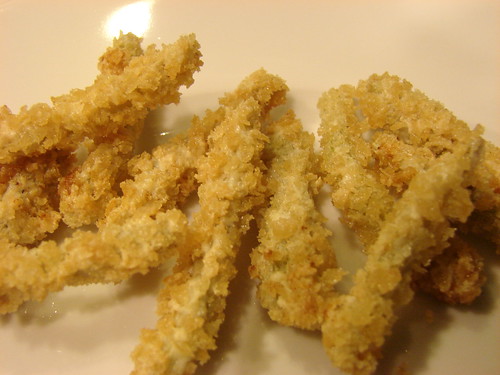
Now, I must admit that the preparation of this side dish took some doing. First, I separated the stems from the chokes, then trimmed the inedible bits. Finally sliced them into sticks before dipping them in buttermilk and panko crumbs in preparation for the fryer. I also breaded the chokes themselves–or tried to. They didn’t really hold on to the buttermilk very well, but they were still delicious, particularly once you got to the hearts. Here’s what I did.
4 artichokes with stems attached
1 lemon
1-1/2 cp flour
1/2 tsp sea salt
1/2 tsp black pepper
1 cp buttermilk (or regular)
1-1/2 cp panko crumbs
Oil for deep-frying
Fill a bowl with cool water and squeeze the lemon juice into it, leave the lemon halves in the water. Cut the stems from the chokes. Pare the tough peel off the stems and drop them in the bowl of water as you remove all the bark. Then trim the chokes by removing loose leaves, and snipping the points of the leaves left. Quarter the chokes and dunk in the water bowl. Slice the trimmed stems into sticks.

Preheat oil to 375°. Set up an assembly line. Combine the flour and seasonings. And put the buttermilk and panko crumbs in 2 separate bowls/containers. First dredge the sticks in the flour, then dip in milk, finally roll through panko. Repeat. The chokes will pick up some of the breading, especially on the areas where the leaves are still tight.
Fry them in hot oil until golden brown, sprinkle some sea salt as you pulled them out of the oil. Enjoy!
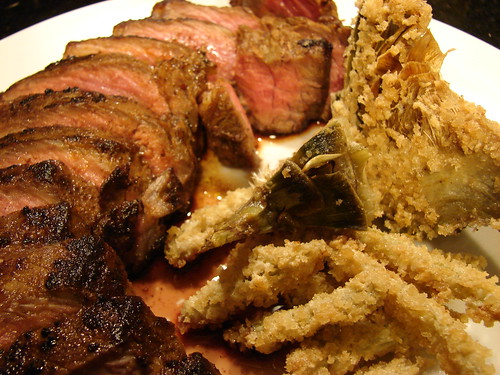
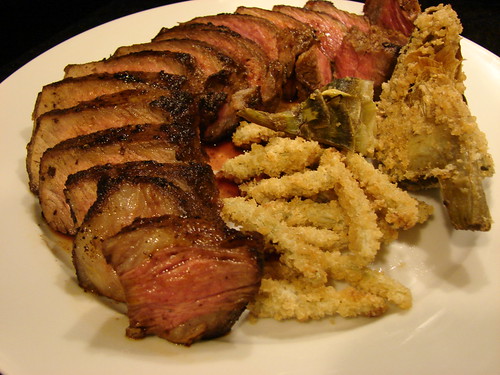
This is what I created with the other half of the items in the bag Lindsay brought home. I won’t bore you with the details of this challenge, you can read all about that in this post.
We’re big meat eaters, the hubby and I. So it was no surprise to find these beautiful strips in the bag. To up the stakes, I decided to season them differently than we usually do and to pair them with 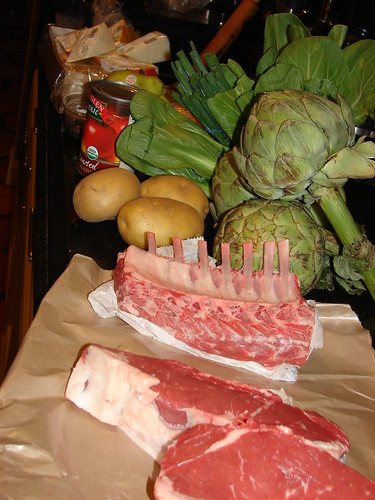 something I had not worked with before. Alas, artichokes! I did have to scour the internet for ideas on how to prepare artichokes. Check out the recipe here.
something I had not worked with before. Alas, artichokes! I did have to scour the internet for ideas on how to prepare artichokes. Check out the recipe here.
My sis-n-law brought me goodies from her last trip to the South of France. She came back with this little bottle of Piment d’Espelette. I had never heard of this before and was dying to try it since I got it, so I used it to marinate the steaks. Usually I would’ve added garlic to a beautiful piece of meat such as this, Herbs d’Provence too. Different. That was my mission. I stayed away from both my favorite steak condiments and ended up with this most incredible steaks. If you do not have access to d’Espelette pepper, you could sub it with hot paprika.
Espelette Pepper Steak
NY strip steaks (about 1lb)
2 tsp Piment d’Espelette
3/4 tsp sea salt
1/2 tsp pepper
1 tsp herbs d’Provence (optional)
1 tbsp extra virgin olive oil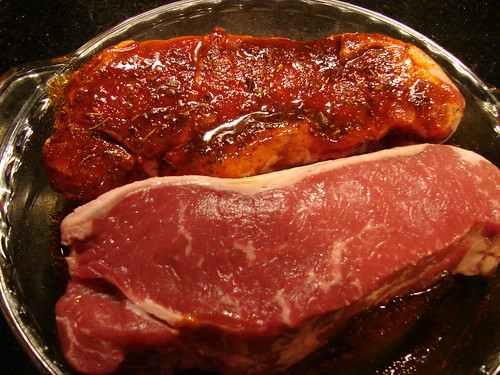
Mix the spices and oil, then rub on steak. Allow it to marinate for 15-30 minutes.
We cooked our steaks on the stovetop, but I’m sure this will work just as well on the grill. If cooking on the stove, use a heavy-bottom skillet; it needs to be able to get pretty hot to sear the steaks without burning them. Heat up the skillet until it begins to smoke, dab the bottom of the skillet with an oil-soaked paper towel or napkin, just enough to ensure the steaks will not get stuck to skillet. Now put the steaks in, try to avoid crouding them on the pan, otherwise they may begin steaming.
Depending on the thickness of the steaks, it will take about 3-4 minutes per side for rare doneness, don’t forget to lay them on their sides to sear the fat as well. Once you’ve cooked them to your taste, remove them from the pan and let them rest for 5 minutes. This allows all the juices to be redirected around the steak. Now eat!
I served these with Artichoke Fries, follow the link for that recipe.
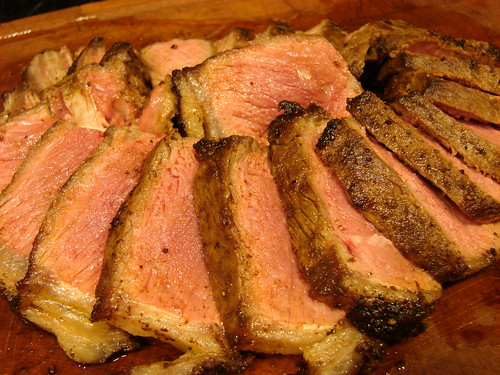
I do love me some George Michael! Are you ready for our first cooking adventure?
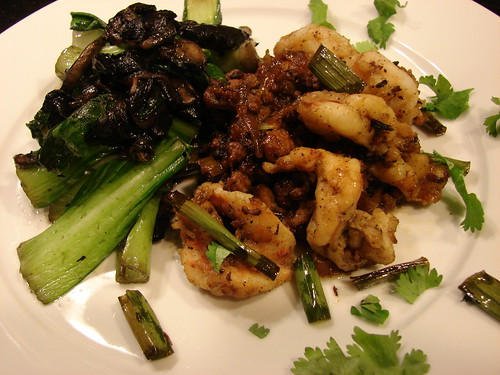
Hubby and I love Chinese food. We also love Japanese food, oh and Thai. Well, we have this thing for Asian food. A few months back a coworker of his invited him over for a home-cooked meal. Linz came back telling me all about the delicious lunch he’d had. About how his coworker’s wife had done her best to explain to him the different sauces and condiments she used. And so, we’ve tried our hand at making some stir fry, fried rice and other Asian inspired dishes.
This is my version of Shrimp and Pork in Pepper Sauce. Here I joined the concepts behind Pork and String Beans and served it with Bok Choy and Mushrooms.
Makes 4 small portions
For the Shrimp
Mix the next 4 ingredients and set aside
½ lb. large shrimp (about 8), halved
2 tsp. light soy sauce
1 clove garlic, crushed
1 tbsp. sesame oil
In a small bowl mix the next 3 ingredients and set aside:
3 tbsp. soy sauce
1 tbsp. oyster sauce
Dash of fish sauce (optional)
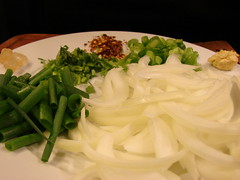 For the pork and sauce
For the pork and sauce
1-2 tbsp. sesame oil
½ lb ground pork
1 large yellow onion, sliced
4 green onions, chopped (separate tops from stems)
3 tbsp. cilantro stems, finely chopped
1 tsp. red chili flakes (optional)
¼ cup vermouth / broth OR water
3 pieces of rock sugar OR 2 tsp. granulated sugar
Heat up a wok or frying pan over high heat; add sesame oil and pork stirring until it browns. Make sure you break the pork into tiny crumbles, add yellow onions and cook until they begin to soften. Add garlic, cilantro, green onion stems and chili flakes. Cook until the onions are translucent.
Now add the soy and oyster sauce mixture, sugar and stir. If you used rock sugar, make sure it has dissolved before adding the vermouth or broth. After adding the liquid , cover and reduce the heat to medium low for another 4-5 minutes. At this point the pork will be completely cooked and tender—be sure to check it; if it’s undercooked it can take on the consistency of day old taco meat.
Add the shrimp halves, stir and cook shrimp until it just loses its translucency, about 3-4 minutes. Cover and turn off the heat. This should be the last thing you do before serving. This would be wonderful over white rice, we served it with bok choy, see that recipe below. Enjoy!
For the side dish…
Bok Choy with Mushrooms
Originally I planned on giving the bok choy a typical Asian flavor, but the mushrooms I had were not what I think of when cooking that type of cuisine so I made a last-minute change. I ended up with a simple and subtle side dish.
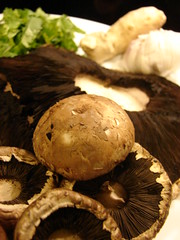
3 1”-pieces of ginger, peeled
A few cilantro strands
2 tbsp extra virgin olive oil
4 bok choy heads(?), washed
1 portabella mushroom, sliced
5-8 crimini mushrooms, sliced
Salt and pepper to taste
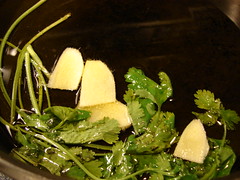
Put the oil in a pan over medium-low heat, add the ginger and cilantro, and allow it to infuse the oil for a few minutes. You won’t need to do much to this, just make sure the heat is low enough to avoid scorching it. In the meantime, prep the veggies.
Make sure you wash the bok choy, separate the stalks and rinse under running water. Chop them into pieces about 2”-long, slice the mushrooms.
Remove the ginger and cilantro from the oil, raise the temperature to medium-high. Once hot, add the mushrooms stirring constantly. Season with salt and pepper. Add the bok choy and toss to incorporate the mushrooms. Cover and reduce heat to medium low. I like my veggies with a bite, so I cooked the bok choy for 5 minutes.
I hope you like it as much as my husband did!
I admit it. It was Sunday, I couldn’t decide on dinner and I was slightly bored. My dear friendster Cindy had given us a gift card to Whole Foods when we got married (we’re still newlyweds!) and so I thought this would be a perfect opportunity to make use of those plastic dollars.
I cozied up to hubby, batted my eyelashes and said, in my most sultry voice: ‘Let’s play a game. You go to the store with this money and buy anything you want and I’ll cook it. I get no input. I’ll cook whatever you bring, even if I’ve never tried it before’.
 Yes, I was feeling brave and daring. I imagined myself a contestant in my show: a cross between the Next Food Network Star, Chopped and Top Chef. When he wasn’t back almost an hour later, I began to worry. Then he showed up with 2 HUGE bags from WF…! yeah, it was time to panic.
Yes, I was feeling brave and daring. I imagined myself a contestant in my show: a cross between the Next Food Network Star, Chopped and Top Chef. When he wasn’t back almost an hour later, I began to worry. Then he showed up with 2 HUGE bags from WF…! yeah, it was time to panic.
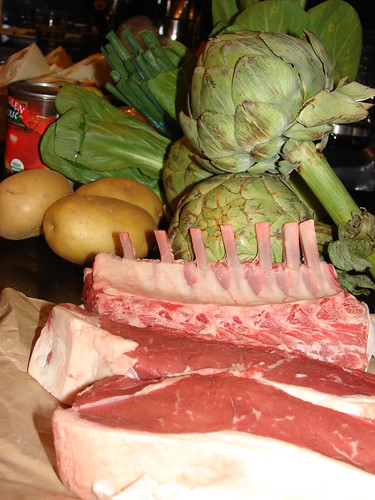
He produced lamb chops (virgin territory), pears, long-stemmed artichokes (never seen those before), potatoes, NY strips, ciabatta bread YUM! bok choy, pasta, and some other goodies. Definitely more than one meal. I paced, drank wine, paced some more and finally came up with a menu!
I would try my hand at the lamb chops and I would serve them over pasta with a Putanesca-ish sauce. I would also try making a pear tart. The deal was I had to do as much as possible without looking for recipes. I was able to do so except for the tart; baking is, after all, science. Here’s how the chops went down.
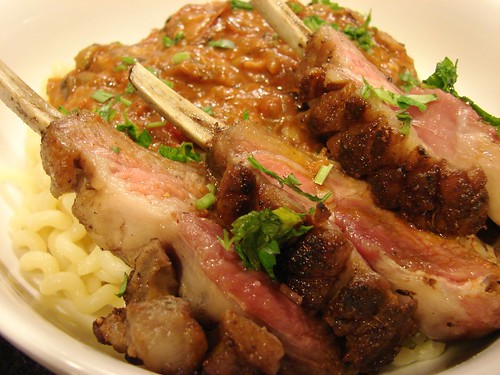
Aren't they beautiful?
Grilled Lamb Chops
1 lb of lamb chops (whole)
3 tbsp olive oil
2 tsp sea salt
1 tsp pepper
2 garlic cloves, crushed
First we scored the fatty side of the rack, then we marinated it.
Marinate: Then I threw the rest of the ingredients into a Ziploc bag, got the salt incorporated and added the chops. I let them hang out there for about 2 hours, turning them every so often.
Preheat oven to 375
Cook: In a very hot oven proof skillet, heat up some olive oil and place the rack fatty side down. You want to sear it about 3 minutes on each side (be sure not to burn it). Keep turning until you get all sides browned, then turn it so the fatty side is on top, and put it in the preheated oven for another 15-20 minutes depending on how you prefer to cook it.
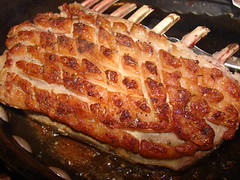
After searing before hitting the oven
Salsa Putanesca-ish
3 slices of bacon, cubed
1 white onion, chopped
2 garlic cloves, crushed
8 crimini mushrooms, diced
1/4 cp Italian parsley, chopped
3 Roma tomatoes, diced
1 can roasted tomatoes
1/2 cp assorted olives, chopped
2 tsp anchovy paste
2 cp good beer
salt & pepper to taste
Saute the bacon to render some of the fat, but keep it soft. Add onions and cook until translucent; then add garlic and mushrooms. Once the mushrooms begin to soften, add the tomatoes, parsley and olives, stir in. Then add the anchovy paste and beer, bring it to a boil then reduce the heat to a simmer. Allow the flavors to cook in for about 30-45 minutes, stirring constantly. You may not need to add salt, but check at the end of the cooking time and adjust seasoning.
Serve: Remove chops from oven and allow to rest for about 10 minutes before slicing. In the meantime, cook, drain and serve your pasta onto a plate. Top with sauce and place a few chops over that, sprinkle with fresh parsley if desired.
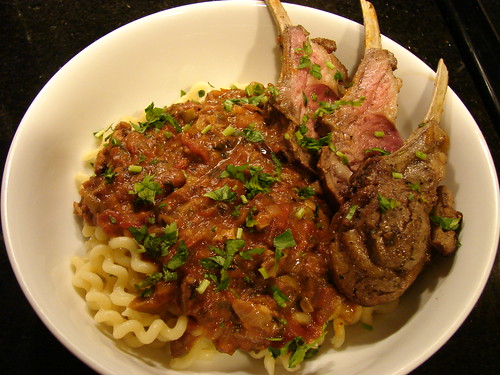

 the other dish, Langostinos en Caramelo de Maracuyá (Prawns in Passion Fruit Caramel) by following this link. And don’t miss the entries submitted by other food bloggers, visit Foodalogue for the tasty bits.
the other dish, Langostinos en Caramelo de Maracuyá (Prawns in Passion Fruit Caramel) by following this link. And don’t miss the entries submitted by other food bloggers, visit Foodalogue for the tasty bits.














 something I had not worked with before. Alas, artichokes! I did have to scour the internet for ideas on how to prepare artichokes. Check out the recipe
something I had not worked with before. Alas, artichokes! I did have to scour the internet for ideas on how to prepare artichokes. Check out the recipe 


 For the pork and sauce
For the pork and sauce

 Yes, I was feeling brave and daring. I imagined myself a contestant in my show: a cross between the Next Food Network Star, Chopped and Top Chef. When he wasn’t back almost an hour later, I began to worry. Then he showed up with 2 HUGE bags from WF…! yeah, it was time to panic.
Yes, I was feeling brave and daring. I imagined myself a contestant in my show: a cross between the Next Food Network Star, Chopped and Top Chef. When he wasn’t back almost an hour later, I began to worry. Then he showed up with 2 HUGE bags from WF…! yeah, it was time to panic.


